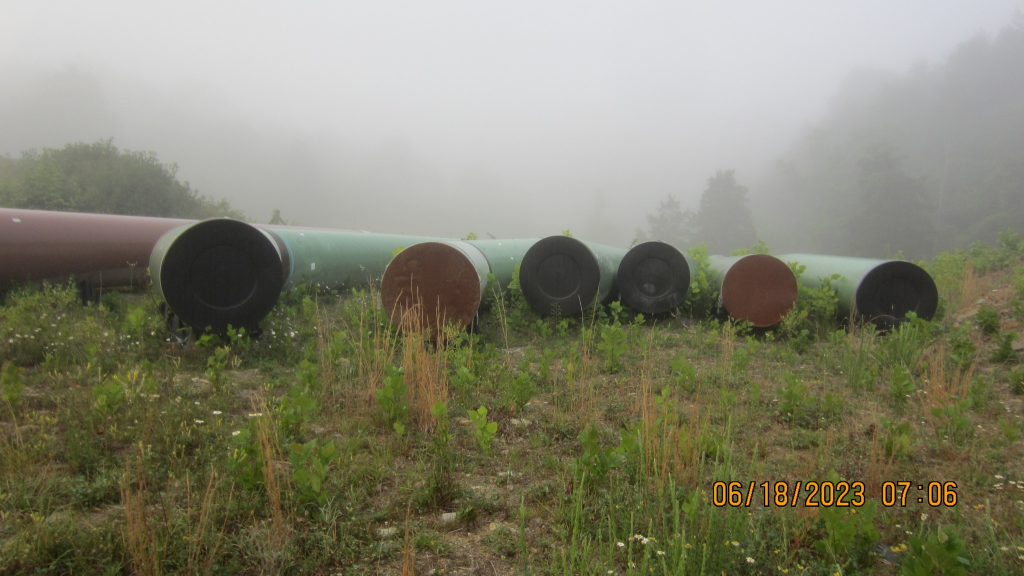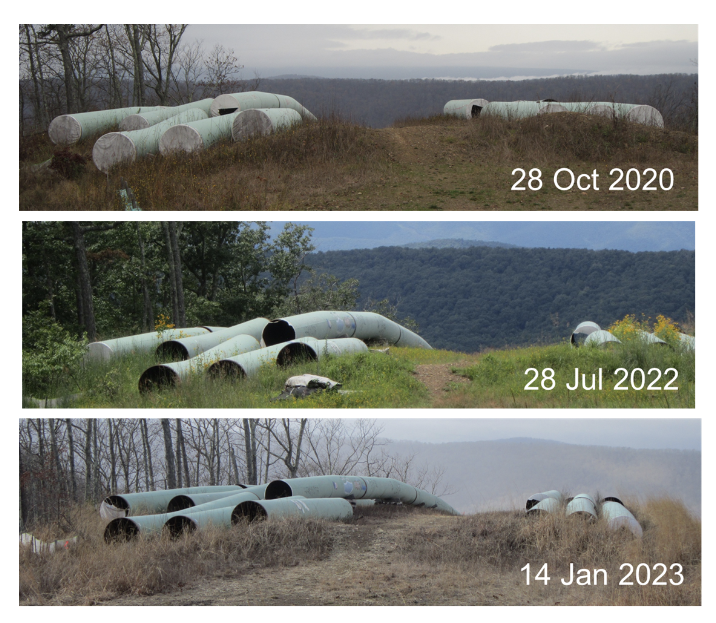Front Porch Blog

Pipe in right-of-way in Monroe County without any protection since October of 2018. Photo courtesy of Maury Johnson
“For nearly four years, I have been working with local residents and others from across the country to sound the alarm about this dangerous degraded pipe and other construction practices that put anyone who lives or visits the area near the Mountain Valley Pipeline pathway in harm’s way. The insanity of this project is multiplied by the disregard that MVP and other public officials have exhibited for the people whose lives and land are being sacrificed for this unnecessary, democracy-ending project.” — Maury Johnson, MVP-impacted resident in Monroe County, West Virginia
Tell regulators to stop work on MVP
until safety standards are met!
For years, community members have warned of the dangers of the Mountain Valley Pipeline — from harm to streams, to the destruction of steep mountains and threats to endangered species. Landowners and those along the route have seen construction stop and start as the project developers repeatedly lost federal permits owing to an inability to comply with environmental laws.
They have watched as sunlight and weather beat down on sections of the pipe and questioned how degraded the materials are. Now as MVP construction is resuming, communities along the pipeline’s route are alarmed at the danger of using the deteriorated components, fearing that the risk for cracks, weld failures, leaks and explosions has increased.

MVP degraded pipe, exposed to the UV light, rain, floods and other impacts, seen here at the convergence of Little Creek and the Blackwater River in Franklin County, Va. MVP seeks to coat all its degraded pipe on site, in the middle of farm fields, risking ineffective, inconsistent recoating and exposure of people, water and crops to industrial sandblasting and coating materials. Photos courtesy of Preserve Bent Mountain
 On August 11, the Pipeline and Hazardous Safety Materials Administration, the agency tasked with monitoring the pipeline, weighed in on the situation by expressing significant safety concerns about MVP. (PHMSA, an agency under the Department of Transportation, was created in 2004 to oversee 3.4 million miles of pipeline in the United States and regulate the shipment of hazardous materials.) PHMSA officials indicated they spent over 200 days in the field observing MVP’s developers.
On August 11, the Pipeline and Hazardous Safety Materials Administration, the agency tasked with monitoring the pipeline, weighed in on the situation by expressing significant safety concerns about MVP. (PHMSA, an agency under the Department of Transportation, was created in 2004 to oversee 3.4 million miles of pipeline in the United States and regulate the shipment of hazardous materials.) PHMSA officials indicated they spent over 200 days in the field observing MVP’s developers.
In their “Notice of Proposed Safety Order,” the agency said MVP requires a “comprehensive evaluation to identify and remediate integrity issues, mitigate the risk and protect public safety, property, and the environment.”
PHMSA’s report on MVP’s unsafe pipes is welcome and is a direct result of the on-the-ground scrutiny community members have kept on this unnecessary, dangerous project. The agency expressed concern with MVP’s methods of reporting construction, the length of time the pipe was exposed to sun, the area’s topography and potential land movement, and the lack of corrosion protection for pipe already in the ground. The notice would require more stringent reporting, evaluation of all unburied, stored pipe by a third-party inspector approved by the PHMSA director and additional testing before gas flows through the pipeline.

Photos of pipes in the Jefferson National Forest adjacent to the Forest Service’s Brush Mountain Road on three dates. Photos were taken from the road looking northwest. Visual observation provides no evidence of any maintenance over this period; while the sole evident protective measure applied originally, fabric cappings for the pipe ends, has fallen into and remained in disrepair. Graffiti is visible on the pipe near the center of the 14 Jan 2023 photo, further indicating lack of pipe maintenance.

Workers focus on an area of a pipe’s coating as they prepare to place it in the trench. Before any restrictions imposed by a proposed safety order can be put in place, MVP has been working around the clock in some locations, including Teels Creek in Franklin County, Va. There, MVP put up lights and ran loud generators, pumping water from trenches through the night within a few hundred feet of the home of an older couple with serious health disabilities. With degraded pipe coating among the major safety concerns, MVP noted an possible coating defect as the pipe was being loaded to the trench. Photo courtesy Preserve Bent Mountain
- Pipe segments have been buried without cathodic protection installed, and without other corrosion control processes and inspections at different junctures.
- Pipe staged along the pipeline right-of-way has been exposed to the elements and ultraviolet radiation for long periods of time.
- Some data from MVP was being recorded on an outdated form that does not represent current processes and procedures governing such coating remediation work.
MVP has 30 days to reply to PHMSA’s findings, but community members are concerned about reports of developers rushing to put pipe in the ground ahead of their deadline for a response. You can speak out on this issue and the need for a pause in construction while the safety review standards are being met.

Photo courtesy of Preserve Bent Mountain
PREVIOUS
NEXT
Related News

Leave a comment
Your email address will not be published. Required fields are marked *

With EQT’s record of a well spilling over 20,000 tons of methane (500,00 tonnes CO2 equivalent) and having eight other wells at risk for this kind of leakage it’s no wonder that we are seeing such shoddy work practice on the MVP.
Has anyone got any picture or video evidence of these sunspots or pipeline buried under rocks that could be used in court?
As for your talk of a ploy, “Jason”, did you look at the pictures above? Sounds like you may have some vested interest in seeing this pipeline go in the ground…
Thank you for the blog post, Jessica Sims!
MVP dynamited a cave within a steep Karst ridge on my farm located on the side of Sinking Creek Mountain in Newport Virginia. They lied about the presence of the cave and their destruction of it for years, denying all the evidence of sinks and speleothems found along the ROW. Photographs taken during trenching clearly revealed an opening into the remaining portion of the cave, complete with a stalactite hanging down into the opening, located inches from the open trench where they buried the pipe. When confronted with that photo, after years of outright lying and denial, the Supervisor for Spread G had the audacity to ask why I had never told him about it. We had filed Cave Reports two years in a row on the Docket, I had contacted DEQ, the Water Control Board, had taken speleothems to meetings to show them, and they continually refused to admit it. The pipe is now buried in the Karst that was destroyed, and erosion and runoff from the side of the mountain where the pipe is buried creates flooding down the mountainside, through the pastures, around the house and routinely washes out the driveway. MVP continues to deny their responsibility for this damage and refuses repairs to the driveway. There is no fix for this. It is frightening to consider the potential for explosion given that the entire farm is in the Blast & Evacuation Zone, and their capacity for lying about what they are doing to our properties.
The pipe that is going in ground is been taken very seriously on the recoating process. The work they are doing is above the standard from the original coating so this ploy to stop work is not going to work. MVP is aware of this attempt and they are going above and beyond to make sure that this attack does not shut them down. Nice Try but not Today.
Many of MVP’s transgressions have resulted in damage which is now done and cannot be undone. The mud that went into our streams and water supplies and the resulting damage is not something the MVP can undo. The erosion paths that they have cut will remain long after they are gone. But explosions have not happened yet and are not inevitable unless no action is taken to prevent them. The explosion of July, 2018 on Nixon Ridge near Moundsville, WV, at the bottom of a steep slope not as steep as the one over Newport, VA, was caused by what MVP refers to as a land slip. MVP has not been able to prevent repeated land slips. MVP has never protected any of its pipe from UV exposure which has thinned the coating by washing toxic dust into our water supplies removes the ability to flex and stay adhered when the pipe is bent. For years citizens have observed where the coatings have just fallen off leaving rust spots. MVP has started doing some patchwork remediation which do not address the flex properties, do not restore full thickness, and probably don’t find all the adhesion. Some of the pipes are freckled with adhesion patches and if they spot 99% of them, that is not good enough. And there is a lot of pipe that has been buried before they started remediation. The third problem is the most egregious. They are unable to prevent the land slops. The sunlight damaged their pipe. Bur citizens have seen where the trench was not properly prepared and pipe was buried amongst rocks. MVP buried the pipe that way. They can blame no one else for doing this. And if they did this where citizens and the Pipeline and Hazardous Materials Safety Administration saw it, two things: MVP is not trustworthy AND the only way to know what they did is to look. And maybe the only way to look is to dig it up. That is surely the only way to remediate the coatings and make them safe. The rocks substantiate citizen contentions that MVP has no respect for the law, the environment or the well being of the citizenry. We must not allow this pipeline to go into operation until it is made safe.
EQT, largest owner of the MVP, has a history of accidents. Last fall a gas well at their Rager Mountain location blew out 1.1 billion cubic feet of Methane. This was one of the largest methane releases in US history. It took 11 days to stop the leak. A followup by the PA DEP found that 8 of the other 9 EQT wells at the site were also leaking.
This company is reckless and incompetent, and can’t be trusted to protect the public safety.
Safety first!
There a LOT of pipe sections which have been on the ground and are visibly aged. They should not be placed in the ground until they are properly recoated.